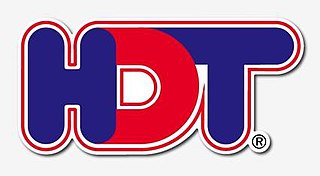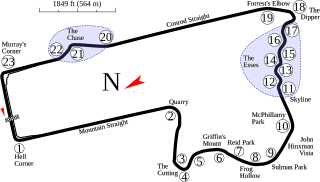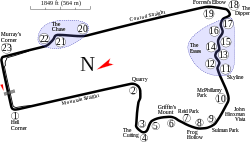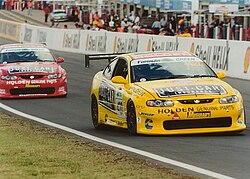
Touring car racing is a motorsport road racing competition with heavily modified road-going cars. It has both similarities to and significant differences from stock car racing, which is popular in the United States.

The Bathurst 1000 is a 1,000-kilometre (621.4 mi) touring car race held annually on the Mount Panorama Circuit in Bathurst, New South Wales, Australia. It is currently run as part of the Supercars Championship, the most recent incarnation of the Australian Touring Car Championship. In 1987 it was a round of the World Touring Car Championship. The Bathurst 1000 is colloquially known as The Great Race among motorsport fans and media. The race concept originated with the 1960 Armstrong 500 at the Phillip Island Grand Prix Circuit, before being relocated to Bathurst in 1963 and continuing there in every year since. The race was traditionally run on the Labour Day long weekend in New South Wales, in early October. Since 2001, the race is run on the weekend after the long weekend, normally the second weekend in October.

Steven James Richards is a New Zealand-Australian racing driver, currently competing in the Porsche Carrera Cup Australia Championship.
Jürgen Alzen is a race car driver from Germany.

Jim Richards is a New Zealand racing driver who won numerous championships in his home country and in Australia. While now retired from professional racing, Richards continues to compete in the Touring Car Masters series.

The Holden Dealer Team (HDT) was Holden's semi-official racing team from 1969 until 1986, primarily contesting Australian Touring Car events but also rallying, rallycross and Sports Sedan races during the 1970s. From 1980 the Holden Dealer Team, by then under the ownership of Peter Brock, diversified into producing modified road-going Commodores and other Holden cars for selected dealers via HDT Special Vehicles.
Garry Rogers Motorsport is an Australian motor racing team. It is owned by retired racing driver Garry Rogers who began the team to further his own racing efforts. Based in Melbourne, originally out of a Nissan dealership owned by Rogers, the team has competed in a variety of touring car series in Australia ranging from relatively modest Nissan production cars to Chevrolet NASCARs to building the GT specification Holden Monaro 427C. The team won the Bathurst 1000 in 2000 and also won both of the Bathurst 24 Hour races which were held in 2002 and 2003. In 2013 the team celebrated its 50th year in racing since Rogers made his debut.

Allan Maxwell Grice, known to motor-racing fans as "Gricey", is an Australian former racing driver and politician, most famous for twice winning the prestigious Bathurst 1000, and as a privateer driver of a Holden in the Australian Touring Car Championship.

The Australian Nations Cup Championship was a motor racing title sanctioned by the Confederation of Australian Motor Sport (CAMS) from 2000 to 2004.

The 2002 Bathurst 24 Hour was an endurance motor race staged at the Mount Panorama Circuit just outside Bathurst in New South Wales, Australia. The race, which was the first 24-hour event to be held at Mount Panorama, started at 4:00pm on 16 November and finished at 4:00pm on 17 November. It was the first 24 Hour race to be held in Australia since the 1954 Mount Druitt 24 Hours Road Race.

The 2003 Bathurst 24 Hour was a motor race staged at the Mount Panorama Circuit just outside Bathurst in New South Wales, Australia. The race started at 2:00pm on 22 November 2003 and finished at 2:00pm on 23 November. It was the second Bathurst 24 Hour.

The 1993 James Hardie 12 Hour was an endurance race for production cars staged at the Mount Panorama Circuit, Bathurst, New South Wales, Australia on 11 April 1993. The race, which was the third James Hardie 12 Hour, was won by Alan Jones and Garry Waldon driving a Mazda RX-7 entered by Mazda Australia.

The 1991 Tooheys 1000 was a motor race which was staged at the Mount Panorama Circuit just outside Bathurst in New South Wales, Australia on 6 October 1991. It was the 32nd running of the Bathurst 1000. The 1000 km race was held for cars complying with the provisions of Australian Group 3A Touring Car regulations with the field divided into three engine capacity divisions. It was the Round 2 of both the 1991 Australian Endurance Championship and the 1991 Australian Manufacturers' Championship.

The 1984 James Hardie 1000 was the 25th running of the Bathurst 1000 touring car race. It was held on 30 September 1984 at the Mount Panorama Circuit just outside Bathurst in New South Wales, Australia and was Round 4 of the 1984 Australian Endurance Championship. This race was celebrated as 'The Last of the Big Bangers', in reference to the Group C touring cars, which were competing at Bathurst for the last time.

The Australian GT Championship is a CAMS-sanctioned national title for drivers of GT cars, held annually from 1960 to 1963, from 1982 to 1985 and from 2005. Each championship up to and including the 1963 title was contested over a single race and those after that year over a series of races. The categories which have contested the championship have not always been well defined and often have become a home for cars orphaned by category collapse or a sudden change in regulation.
The 1986 Australian Touring Car Championship was the 27th running of the Australian Touring Car Championship. It began on 2 March 1986 at Amaroo Park and ended on 13 July at Oran Park Raceway after ten rounds. This was the second ATCC to be run to the FIA's international Group A Touring Car Regulations.
Procar Australia was a motorsport category management company which operated in Australia from 1994 to 2004.

The Holden Monaro 427C was an Australian built and designed GT style race car based on the Holden Monaro CV8 road car. The car ran in the Procar Australia-run Australian Nations Cup Championship and at the short-lived Bathurst 24 Hour race at the famous Mount Panorama Circuit in Bathurst.












